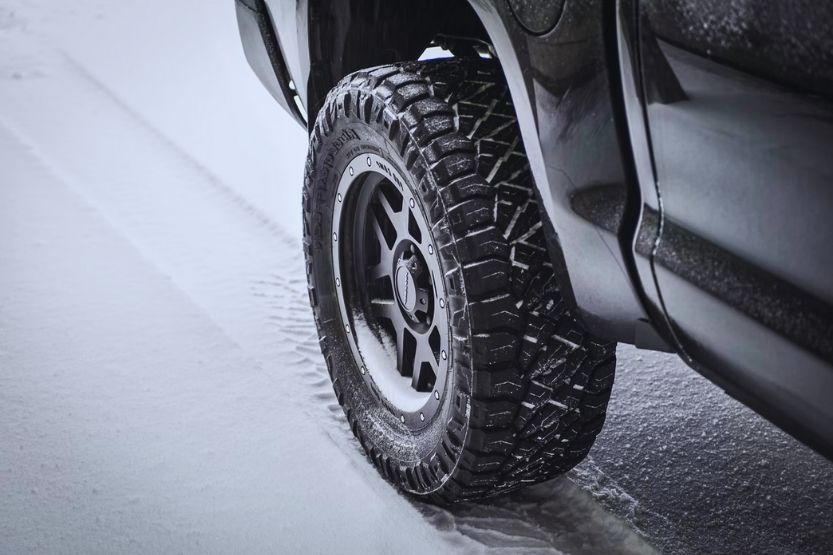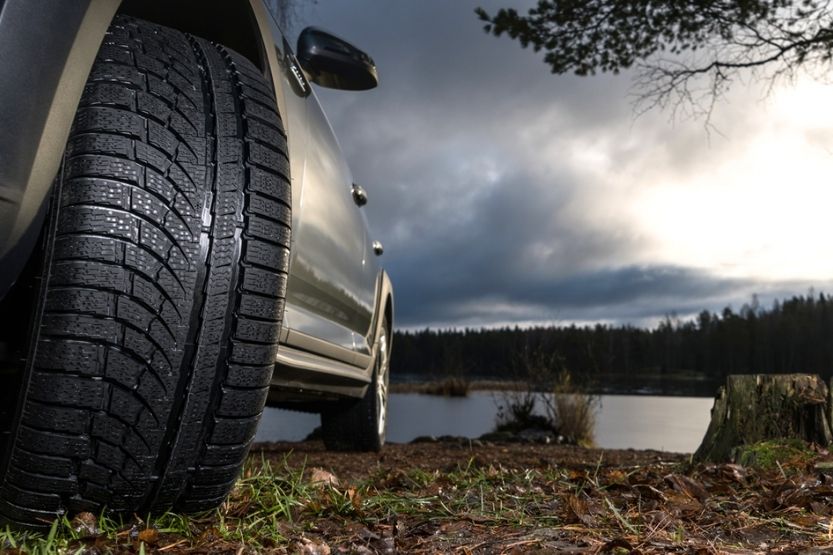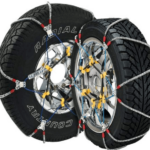Driving in deep snow is not only difficult but is also outright dangerous. This is especially true if you do not have any traction-assistance devices installed on your vehicle. With that said, you may want to know which one is better – snow tires vs. chains?
Most people choose to use snow chains because they cost considerably less than snow tires. For some potential users, this is reason enough. In addition, chains bite deeper into packed and deep snow. This is something that most snow tires have trouble doing.
Snow chains are also easier to install and remove. You can even do it yourself quite easily. This makes it better if you will only be driving through inclement winter road conditions several times throughout the year.
Read on to learn more about the differences between snow tires and chains and which is better for you.
Snow Tires Vs. Chains

If you will be driving through snow-covered roads, which one should you pick? Which side are you on in the chains vs. snow tires debate?
Most people find snow chains the best option because they are cheaper than getting an entire set of winter tires. They are also easy to mount and unmount depending on the road conditions. However, winter tires also provide benefits that tire chains do not.
Advantages of Snow Tires
Snow Tires Are More Comfortable
Compared to chains, you are generally getting a smoother and less bumpy ride when driving on snow tires. The studs embedded in the tread are not quite as chunky as chains. Despite that, they still provide a good grip on the road surface.
Can Be Used All Year Round
There are snow tires that you can use even without snow. These are the ones that have large treads and no spikes embedded in the rubber. However, it is not recommended to use all-rubber winter tires on dry pavement as they will wear out quite fast.
Disadvantages of Snow Tires
Expensive
Snow tires are quite expensive to buy. The cheapest ones are around $80 each, while the higher-end ones cost more than $200 each. Aside from the tires, you will also need to buy rims for them. You will also pay for installation if you don’t have the time or equipment.
Do Not Provide Enough Traction in Deep Snow
Even though they look like they’d be great for going off-road, snow tires are essentially just for road use. If you drive over a road covered in snow, you will discover that it will not grip quite as much.
Advantages of Snow Chains
Inexpensive
You can already get a good set of snow chains for $100. These inexpensive sets are already the fancy ones with auto-centering and tensioning features.
Easy to Install
Even if it is your first time doing so, you will find that installing tire chains is quite easy. Once you get used to doing it, you can install snow chains in less than five minutes.
Provides Excellent Traction
Compared to snow tires, even those with steel studs, snow chains provide better traction over deep snow and ice on the road. Aside from the spikes on the chain, the links themselves can bite into the snow. This can give your car a good grip.
Disadvantages of Snow Chains
Illegal to Use on Non-snowed Pavement
If you are driving on clear pavement again, you’ll only need to pull over and remove your chains immediately. Not only will you most likely get a citation, but the chains will also tear up the road.
Bumpy Ride
Snow chains will be adding a considerable amount of “chunkiness” to your tires, so your ride may be quite rough. Make sure that your car’s suspension will be up to the task of dampening the bumps. If not, you will be in for a bone-jarring ride.
Again, snow tires vs chains – which is better? Snow chains are more affordable than snow tires. However, both provide additional traction when driving during icy conditions. But, snow chains are difficult to install and can potentially damage your tires.
What Are All-Weather Tires?

Aside from snow tires, you can also outfit your cars with all-season or all-weather tires. These tires might not provide the same traction as actual snow tires.
However, if you live in an area where the snow doesn’t get that deep, the said tires may be better choices. You might think that all-weather and all-season tires are the same, but they are quite different.
Advantages of All-weather Tires
1. Gives Plenty of Traction in Inclement Weather Conditions
An all-weather tire is a hybrid. You can expect it to give your car plenty of traction in mildly inclement weather conditions. These include the rain and maybe even sleet.
2. Work Great During the Winter
In certain ways, all-weather tires provide you with the best of both worlds. They provide great performance during the summer, spring, and autumn months, just like all-season tires. However, they also work great during the winter (however, not in deep snow, of course).
3. Do Not Need Storage During Winter
In addition, snow tires need to be stored when you are not using them. This means they will be taking up a lot of space in your garage. You do not also need to bother having to install and unmount all-season tires when it suddenly snows.
4. Road Legal During Snowy Conditions
The DMV recognizes that all-weather tires are road legal during snowy conditions like snow tires. To identify an all-weather tire, check the sidewall. You should be able to see either a 3-peaked mountain or a snowflake logo.
Disadvantages of All-Weather Tires
Short Lifespan
One downside of all-weather tires is that they typically don’t last quite as long as an all-season and winter tire.
Short Tread Warranties
Most all-weather tires have relatively short tread warranties, making sense because you can use them all year round. Meanwhile, you will need to swap out your regular tires for all-season tires.
What Are All-Season Tires?
Most people think that “all-season” is equivalent to “all-weather,” and it does seem logical, but they are not the same.
All-season tires are also sometimes referred to as “3-season” tires. The main reason is that they do not meet the safety requirements for driving in heavy snow. Unlike actual snow tires, all-season tires lose a significant amount of performance when the temperature dips below 7° C.
Equipped with Tread Pattern Designed to Get Rid of Mud and Slush
These tires have a tread pattern designed to get rid of mud and slush. They also provide low-rolling resistance rather than providing stability. This means that all-season tires are technically not ideal for winter driving.
Alternatively, mud and snow tires are a kind of all-season tires approved for the road conditions mentioned above. Unlike regular all-season tires, the authorities approved M+S for use in snowy road conditions. This is up to a depth of up to 3.5 mm.
Disadvantages of All-season Tires
Do Not Provide Much Traction During Winter
All-season tires do not provide as much traction when it is snowy. You will need to drive rather slowly when going through a snow-covered road. The reason is that once the wheels start spinning, you will lose control of the car.
How to Install Tire Chains

The procedure of installing tire chains typically depends on the kind and brand you will be using. This guide will teach you how to install the most popular design of snow chains:
1. Park Your Car in a Flat and Level Area
You will need to park your vehicle on a quite flat surface to install the chains straight. If your driveway is long enough, you might be able to use it.
2. Unpack and Spread the Chains in Front of the Tires
Unlike installing snow tires, you do not need to jack up the car to install the chains. You need to unpack the chains. After that, lay them in front of the tires you want to install them onto.
3. Connect the First Link Around the Tires
Wrap the first links of the snow chains around the tire. Ensure the links are secure because you will be rolling the tires over the chain.
4. Let Your Car Roll Over the Chains
You don’t even need to start the engine. You can just put the shifter in neutral and let the car roll over the chains. Let the tire make almost one complete revolution. Put the gear in the park and pull on the emergency brake to prevent the tires from rolling.
5. Attach the Last Links and Tighten the Chain
If the chain has not draped over the tire completely, you can do it by hand at this point. Once the chains have draped over the tire, connect the last links to secure the chain. You then need to adjust the tension of the chains. That way, they would hug the tires snugly without whipping around while you are driving.
Snow Tires Vs Chains – Which One Should You Choose?
Most people choose snow chains over tires mainly because it is a more economical choice. However, it may not be practical if you do not live in a place where there is snow. Getting a set of tires for deep snow may be unwise if you do not encounter such snowy conditions.
Snow chains, on the other hand, are easy to install and remove when needed. They are also very affordable. You can buy a quality set of snow chains for almost the same price as a cheap snow tire. Unless your living circumstances demand it, it is best to get snow chains instead of snow tires.
FAQs – Snow Tires vs Chains
Where Do You Install Snow Chains?
Technically, you will only need to install snow chains on one axle. It is also advisable to install the chains on the “powered” wheels only. For instance, the snow tires go on the front wheels if you drive an FWD vehicle.
Do 4-Wheel Drive Vehicles Need Snow Chains?
Even 4WD vehicles will need snow chains or snow tires. It does not matter if all axles have power. If there isn’t any traction, it will not move forward. Ideally, you should put snow chains on all four tires unless the manufacturer advised you not to. If you can only put two, they should be on the front wheels.
Why the front? This is because the braking momentum of vehicles tends to push all the weight to the front. Having more traction there means your braking distance will be shorter. Also, having more grip on the wheels in charge of the steering will provide you with better handling.
Conclusion – Snow Tires Vs Chains
Many people choose snow chains over tires because they cost considerably less, and this, alone, should be reason enough. In addition, snow chains provide better traction on deep-packed snow. This is something that even studded snow tires have difficulty with.
Should you choose chains over snow tires? It depends on the usual weather conditions where you live. If the winters get rather brutal, it might be good to get a set of winter tires. However, if you only use them for extremely bad weather, the snow chain is the more economical choice.


![How to Put Chains on Tires [Easy Steps] how to put chains on tires](https://roadsumo.com/wp-content/uploads/2022/01/how-to-put-chains-on-tires-150x150.jpg)



![What Are Snow Tires [Do You Need Them?] what are snow tires](https://roadsumo.com/wp-content/uploads/2022/10/what-are-snow-tires-150x150.jpg)
![Read more about the article Michelin Tires at Costco [Are They Good? Cheaper?]](https://roadsumo.com/wp-content/uploads/2022/03/Michelin-tires-at-Costco-300x200.jpg)

